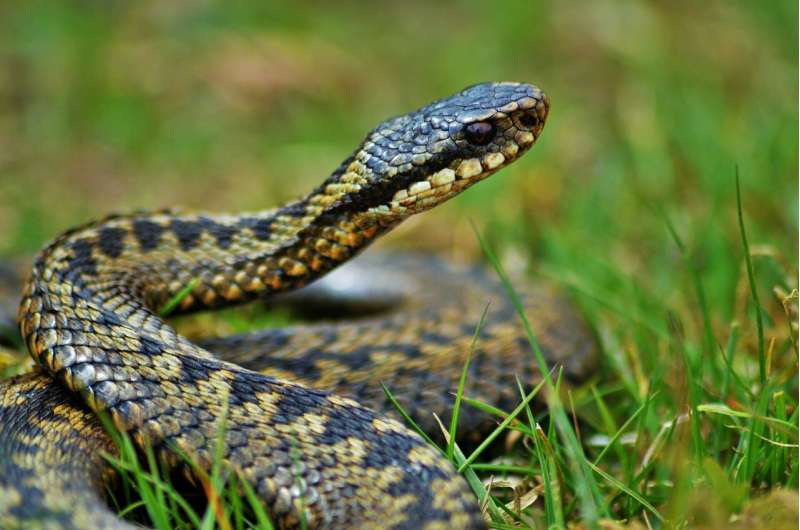Adders are facing near extinction in Britain according to study of national adder population trends

The adder could all but disappear from the UK countryside by 2032, according to new research conducted with the help of citizen scientists.
The findings, published in the Herpetological Journal, are the culmination of 11 years of nationwide monitoring and showed that 90 percent of adder populations surveyed were declining. Experts warn that, if these trends continue, within just 10-20 years adders could be restricted to just a handful of sites in the UK.
The adder is a conservation priority species in the UK. Although concern has been growing among reptile experts for decades that our native adder populations are in decline, this study is the first time that national adder population trends have been measured, and the data confirm that our adders are in serious trouble.
The data were collected by Amphibian and Reptile Groups of the UK (ARG UK) through the 'Make the Adder Count' project, a citizen science survey to monitor adder populations across the UK, which was set up in 2005. Each spring, volunteer surveyors visit their local adder sites to count the numbers of animals, in order to assess whether populations are changing. Dr. Emma Gardner, a researcher from the University of Reading, has analysed the first 11 years of monitoring data.
"Our analysis shows that 90 percent of the sites surveyed have small populations and on average these small populations are declining." said Dr. Gardner. "When surveyors visit these sites, they typically record less than 10 adders. Only 10 percent of sites have large populations, which seem to be doing ok. If these trends continue, within 10-20 years, adders will be restricted to just a few sites in the UK, significantly increasing the extinction risk for this priority species in Britain."
This is not just bad for adders. Adders are an indicator species. If adders are in serious decline, this suggests many other species who depend on the same habitats are likely to be suffering too. So why are so many adder populations in decline and what can we do about it? The study also identified key threats currently affecting the adder sites. Top of the list was public pressure through disturbance.
"Almost half of the adder sites surveyed reported public pressure through disturbance as negatively affecting their adders." said Dr. Gardner. "This ranged from people inadvertently trampling vegetation, to off-lead dogs disturbing the adders and people getting too close trying to photograph them. We know that there are some sites were adders live perfectly happily alongside people, so we really need more research to assess the impacts of disturbance on adders and identify what conditions are needed to allow both adders and people to enjoy the same spaces together.
Another critical factor is how adder habitat is managed. Sadly, adders may not be safe from harm even on nature reserves, where vegetation is often mechanically cut or grazed to maintain it in optimum condition.
"Mechanical cutting can physically injure or kill adders, and overgrazing removes the cover they need to hide from predators and safely hunt for prey." said Dr. Gardner. "Adders are very faithful to their homes, will hibernate year after year in the same place and often hibernate together, hidden away under a tree stump or in a bracken bank. If management operations accidentally destroy these hibernation places, then a whole adder community can be wiped out in one go."
ARG UK and its volunteers are working hard to try and turn things around for adders. Special projects like 'Adders are Amazing!' aim to change public perceptions of adders and encourage everyone to champion and cherish this much misunderstood species. As part of the project, supported by the Welsh Government and Pembrokeshire County Council, ARG UK's Dr. Sam Langdon works alongside schools, community groups, local conservation partners and landowners on the St David's Peninsula in Pembrokeshire, to help safeguard the future of their local adder populations. This summer, ARG UK are also hosting a two-day symposium, 'Vanishing Viper 2019: A European approach to developing an adder conservation strategy', bringing together adder workers from across Northern Europe to identify solutions at a pan-European level.
Right now, adders across the UK will be emerging from their winter hibernation. ARG UK volunteers will continue to count them and monitor their population levels through 'Make the Adder Count'.
"Our study has shown just how vulnerable our UK adder populations are," says Dr. Gardner. "And how important it is that we act now to help conserve our adders, before it is too late."
The adder is a 'Section 41' species, which means that it is listed as a conservation priority under section 41 of the Natural Environment and Rural Communities Act 2006.
More information: Emma Gardner. January 2019, Herpetological Journal (2019). DOI: 10.33256/hj29.1.5770
Provided by University of Reading
















